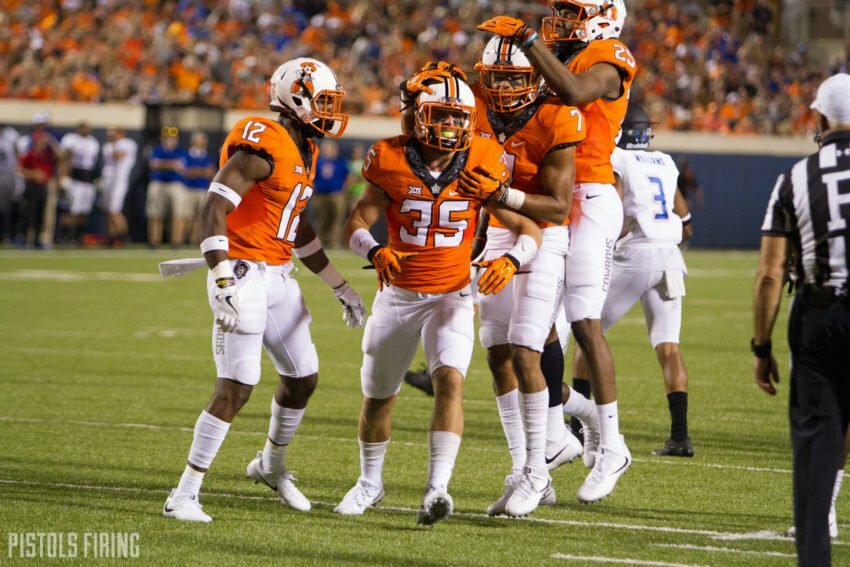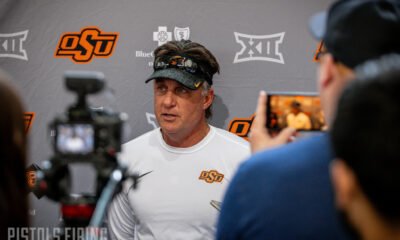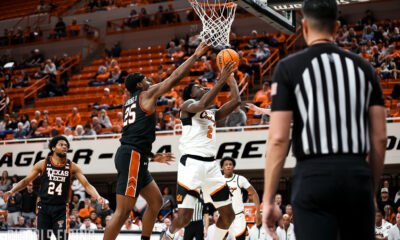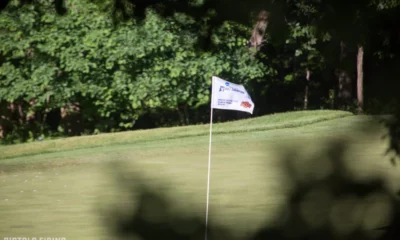Football
Five Stats: Rudolph’s Efficiency and Third Down Woes

Oklahoma State was impressive in their dominating, season-opening victory over Tulsa. Now that I’ve gotten my sheer excitement for college football’s return out of my system, I can focus more on what actually happened.
There were five stats and numbers that really intrigued me after the game on Thursday
300
This was just the fourth time since 2000, and the first time since 2012, that OSU had 300 yards through the air and 300 yards on the ground.
They had 308 passing yards, 332 rushing yards. That’s a run-pass balance that has to put a smile on Gundy’s face. That stat seemed shocking to me. As potent as Oklahoma State’s offense is regularly, and as balanced as Gundy likes to keep the offense, it seems like it would have happened more often.
More than anything, I think this speaks to the rebuilding job OSU has done with the run game. Before last season, 2012 was the last time the Cowboys had a 1,000-yard rusher (Joseph Randle had 1,417 yards). Against Tulsa, OSU was 13 yards away from three running backs with 100 yards.
- Justice Hill – 132
- J.D. King – 95
- La’Darren Brown – 92
OSU doesn’t have a running back on the team older than a sophomore. That should make us all feel good for the future.
82
Speaking of the number four …
In the third quarter, TU quarterback Chad President fumbled the ball inside the redzone. Linebacker Kenneth Edison-McGruder smartly picked up the ball and ran it back 82 yards for a touchdown. It was the fourth-longest fumble return in school history, and the longest since a 93-yarder versus Kansas in 2002.
Edison-McGruder had himself a game, finishing with five total tackles, a sack, and a tackle for a loss of 11 yards that killed a Tulsa drive, and a pass break-up.
Not to overreact, but by the end of the season, Edison-McGruder might end up being the guy we didn’t talk enough about coming into the year.
232
That’s how many total yards Oklahoma State had in four scoring plays. Not drives… plays.
• 40 yard pass to Washington
• 44 yard pass to Johnson
• 71 yard run by J.D. King
• 77 yard pass to Washington
OSU had a knack for tossing the long ball last year, but it could be even better this year. After a summer of talk and rumors, we finally saw the talent that is Tyron Johnson, and he did not disappoint. Playing on the opposite side of the field from Washington is going to make defensive coordinators wake up at night in a sweat.
Not to mention that 71-yard run that introduced us all to J.D. King, and solidified why Coach Gundy and Co. picked him to back up Justice Hill. That was the longest rushing play since 2011 (until LD Brown usurped it a few drives later with a 73-yarder).
20/24
Did you know that Mason Rudolph’s four incompletions are the fewest he’s ever had in a game where he threw at least 20 passes? The next closest was five against UT San Antonio back in 2015.
Taking it one step further, at least one of those incomplete passes was on the receiver. It happened in the first quarter when Rudolph shot a rocket to Chris Lacy on the left side of the field, and Lacy couldn’t hang onto it.
Don’t tell me “it was just Tulsa” unless you want to make the same excuse for that quarterback in Norman finishing with just one incompletion against UTEP.
While we’re on Mason Rudolph records, he’s now gone five straight games without throwing an interception, the longest run of his career. He’s also thrown 147 straight passes without an interception, the second longest stretch of his career, and the third longest in OSU history.
These are the kinds of things Heisman and conference title winners do.
61.5
Here is the stat myself, and many OSU fans, aren’t happy about. Tulsa was 16-26 on third downs for 61.5 percent efficiency. Here are the distances of the successful third down plays that turned into first downs: 16, 5, 2, 7, 10, 1, 10, 7, 14, 10, 7, 8, 1, 2, 1, 3.
With TU’s strength on the offensive line and the run game, the short plays aren’t the real problem (though they’re not great). However, nine of the 16 were seven yards are longer. That is a problem and one that OSU had last year too.
“I’m willing to bet more than eight of them were third and 10 or more, which is generally a conversion rate of about 18 percent,” said defensive coordinator Glenn Spencer after the game. “Without being able to spit it out right now, I’m going to guess it was everybody. That’s something we’ve got to get better at. You’ve worked too hard to get to that point. Everybody is fired up for third and 15, and we’ve got to get off the field.”
Spencer is right the they have to figure out how to be better at getting OSU off the field on third down, especially long third-downs. If they don’t, it’s going to come back to haunt them against better competition.

-

 Hoops4 days ago
Hoops4 days agoFIU Transfer Arturo Dean Commits to Oklahoma State
-

 Football5 days ago
Football5 days agoThe Top 5 Quotes from Mike Gundy’s Final Spring Practice News Conference
-

 Hoops3 days ago
Hoops3 days agoTexas Tech Transfer Robert Jennings Commits to Oklahoma State
-

 Golf4 days ago
Golf4 days agoOSU Freshman Preston Stout Sinks Long Putt to Earn Share of Big 12 Title






